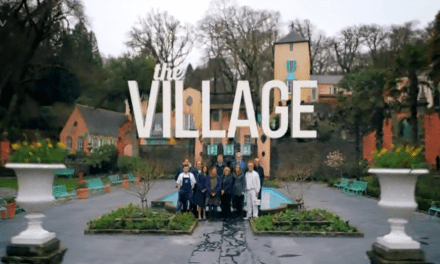Netflix’s Jessica Jones and the BBC’s Happy Valley, on the surface, may seem to provide different viewing experiences, yet they share certain distinctions beyond the obvious element of both series depicting leading female detective/crime-solving characters. Both programmes are examples of a female-centric or feminine style of film/television making, that in the words of Chris Holmund (2016) offer an alternative or different television language, and that as a consequence serves to “bring forward ethical perspectives often missing from action-driven movies” (Holmund 2016). Central to this idea is Holmund’s observation and examination of Mutual Muses’ (2016), or the critical and artistic relationship (“alliance”) between female directors/producers and their female leads. This dynamic, largely examined by Holmund through film, has however become more common in television.
Both Jessica Jones (Netflix) and Happy Valley (BBC1) not only depict female-led dramas, but they are also created, written, and produced by largely female teams – Melissa Rosenberg for Jessica Jones; Sally Wainwright for Happy Valley. Holmund’s work in female-led Independent Cinema therefore, along with other academic work in this area (Caroline Bainbridge’s A Feminine Cinematics, 2008), suggest that women-led productions not only represent and construct female characters differently to the largely male gaze cinematic/television experience, but that this dynamic also offers a “feminine subjectivity” (Bainbridge 2008) to the viewing experience. Both Jessica Jones, Happy Valley, and other examples, such as Scott and Bailey, and most recently, Vera (ITV) can be described as television involved in “the need to speak the feminine, to articulate it and to give it room for enunciation” (Bainbridge 2008).
Although much of this research has been applied to film, it still offers an opportunity to consider these approaches and values in relation to television and to two different television series. As Holmund states: “Muses are typically thought of as women who inspire male artists… But what of female directors and stars?” (Holmund 2016). And as with Holmund’s approach to this dynamic, the object of this paper is not so much to consider these programmes as ‘different from’, but as offering “’difference for’ others with ethical implications” (Holmund 2016).
Netflix’s Jessica Jones stars Krysten Ritter as the eponymous superheroine or anti-hero, and its production as an ‘original’ series is created and produced by Melissa Rosenberg whose writing and production credits include Twilight, Dr. Quinn, Medicine Woman, Ally McBeal, Dexter, amongst others. Rosenberg, along with Kate Schumaeker, is also the creator of ‘Tall Girls Productions’, which she describes as “a production company… dedicated to creating muscular, complex roles for women – in front of and behind the camera”. (Facebook 2016).

Muscular and complex are certainly descriptions which could be applied to the fictional character of Jessica Jones. She represents something of a departure from the traditional Marvel/Superhero storyworld and as such, both the character and the series offer a fresh approach to a recognized genre that may say something about the director-actor dynamic. Jessica is a ‘retired’ superhero, suffering from PTS disorder, and comes with a host of personal problems that presents a more adult interpretation and experience of the Marvel world. In some ways the series offers not so much a rejection of the traditional male-oriented Marvel storyworld, as a focus on feminine subjectivities. The series is notable for its attempts to provide viewers with an emotional journey and for depicting more complex interrelationships between the character and the world she inhabits.
For Rosenberg the creation and writing of the Jessica Jones was “a much more interesting character to write for than Wonder Woman. Wonder Woman is so noble and heroic, and I don’t find that as interesting as one who’s really damaged and flawed…” (2016). Action, therefore, in Jessica Jones is seen as secondary to this observation of character, and it is interesting to note that Jessica Jones’ superpowers are often revealed throughout the series without fanfare, often reluctantly (she has ‘retired’), or through confessional scenarios, tinged with guilt. For the character of Jessica Jones, her most difficult encounters and conflicts are ones in which her superpowers are of little or no use – her relationships with friends and business associates (Trish, Malcolm and Jeri Hogarth), and the largely non-physical, psychological conflict with her arch-enemy Kilgrave. This dynamic sets the tone of the series and is represented through numerous dialogue-driven soul-searching scenarios where relationships and friendships are evaluated, questioned, and consolidated. This is entirely in-keeping with certain aspects of female-led indie films as observed by Homund, where the films themselves often place their focus “on quiet, seemingly inconsequential moments” (Holmund 2016). It is a style that paradoxically re-articulates something similar found in the films of a predominantly male mumblecore group – a group that creates films around the seeming mundanity of everyday life.
Although this idea is alluded to in Jessica Jones, partly as a means to show a representational distance from the likes of Wonder Woman, the feature of the less-than-glamorous mundane every-day is a dominant feature of Sally Wainwright’s writing in Happy Valley and in other similar series. As Andrew Anthony in the Guardian has pointed out, “there is a respect [in Wainwright’s writing] for the drudgery and humdrum nature of much of life” (Guardian, February 2016), but we can also consider how this feature of Wainwright’s writing fits in with Holmund’s ‘quiet’ and ‘seemingly inconsequential’ motif of female-centric productions. In Happy Valley the juxtaposition between police duties and personal dilemmas are often indicated through contrasts of pitch and tone that find further expression in the home or family setting. As Kristyn Gorton points out, although the series resonates with themes of anger and injustice, “as women, this anger and injustice is worked through in terms of family” (2016). It is noticeable in the series – a series which Gorton describes as a “tale of family secrets” (2016) – that psychological development of the character, as well as development of plot, often takes place through quiet, seemingly inconsequential conversations between Sergeant Cawood and her sister in the family home. For Gorton, this is a significant element and one which shows how Wainwright has focused on in developing what has historically been considered a male genre.
Just as significant is how these female-led series and creators deal with women and the way they represent women at the front of their worlds and of their narratives to create a feminine subjectivity. Holmund is particularly interested in reading feminine subjectivities through acting styles and ‘gestures’ – what Holmund describes as actresses translating the “ethical dilemas and choices of their characters through the minutae of their performance” (2016).
These features of gesture and of acting styles are aspects which Bainbridge observes also in her study of the work of Irigaray and its application to A Feminine Cinematics. But Bainbridge further observes “notions of female geneology and the female imaginary…the difficulty of language and discourse; the cultural determination of what constitutes the feminine…sexuality and mediation”, that run through many female-directed and female-led films. Bainbridge also notes other recurring themes that portray associations between women and nature and women and a fear of madness (Bainbridge 2008). Although both Holmund and Bainbridge focus largely on the dynamics of ‘mutual muses’ in independent films, these approaches and specific aspects of the feminine, as well as the concept of a feminine subjectivity, may also offer a way of examining female-led TV programmes such as Jessica Jones, Happy Valley, and Vera.
For Holmund, quoting Perkins, another feature or theme represented through the mutual-muses dynamic are the ways “characters express and perform attitudes of care. The constant, implicit question of how to relate to others is framed by specific situations (2014: 146)”. It is perhaps a significant observation, especially when related to both Jessica Jones and Happy Valley. In both television series the lead character’s (Jessica Jones and Sergeant Catherine Cawood) ability to perform their job is often frustrated or complicated, not so much by the procedures and the element of crime itself, but by specific and often personal situations/interventions where attitudes of care and of how to relate to others become part of the investigation. It is these relationships and attitudes that inform the narrative and in some respects the re-articulation of the genre. Sarah Lancaster’s character in Happy Valley, Sergeant Cawood, is largely driven in her police work by the effects crime has had on her personal relationships – between her sister, her dead daughter, her nephew – and it is these aspects of emotional attachment that potentially relate to a feminine subjectivity in this series. As Gorton states, Wainwright “uses emotion as both a way to engage her audience and as a means to demonstrate the way women, in particular, work through the anger resonant with the male protagonists of social realism.” (2016).
Similarly, there are ongoing dialogues between official duties, sanity and perception in the series, dialogues that are ever-present in Jessica Jones. And whilst the relationship between women and nature is largely internalized in Jessica Jones, the enclosed physical environment of the Calder Valley in Happy Valley is used both as a confine and a retreat for the Sergeant Catherine Cawood. The point is, there is an association with nature in Happy Valley that works to suggest a feminine subjectivity in this crime drama. As Gorton points out, location and nature in Happy Valley works towards “themes of escape” (2016), but also indicates a natural rawness of emotion exhibited by the main character. Happy Valley not only places a female voice in the crime drama, but uses location and surroundings also to say something about that voice and character.

Location in Happy Valley also highlights issues of class, an aspect that both Holmund and Bainbridge observe as present in any concept of a feminine subjectivity in film or television. For Holmund, her understanding of a feminine subjectivity is influenced by the writings of Irigaray, and in particular the “establishment of non-hierarchical relationships grounded in respect for difference. However, Holmund observes that “class serves as a prime indicator of difference among women.” (2016) in the films she analyses, and suggests it as a further feature of a feminine subjectivity. Gorton, in her study of Happy Valley recognizes that class is an important element for both writer/creator and character. The character of Sergeant Cawood represents a volte-face to hierarchy as well as the idea of the glamorous middle-class aspirant female detective. Yet this prime indicator of difference is seldom exercised in the small community of the Calder Valley. This is not the case in Jessica Jones. The character of Jessica Jones moves between social strata and of interest is her complex and often suspicious relationships with women of a perceived class difference such as Trish (high-flying former model, child star and famous radio host) and more obviously, Jeri Hogarth (attorney). It is also interesting that for the television series, the gender of Jeri Hogarth was changed from male (in the original stories) to female for the series. Again, these dynamics offer opportunities for an exploration of notions of the female imaginary and the cultural determination of what constitutes the feminine.

Both Jessica Jones and Wainwright’s Happy Valley potentially add to a description of the feminine imaginary and to concepts of a feminine subjectivity. Both programmes respond differently to this perceived dynamic, but it is interesting how they both involve themselves in scenarios of investigation and in attempts to right the wrongs of injustice. Of equal significance is the ways in which these two programmes potentially represent the dynamic of Holmund’s ‘mutual muses’. They are constructions and depictions of women by women and as such they offer an alternative to the male gaze.
Note: Chris Holmund’s Mutual Muses will be published this later this year in Linda Badley, Claire Perkins and Michele Schreiber’s Indie Reframed: Women and the Contemporary American Independent Cinema. Edinburgh UP.
Kenneth Longden is currently an Associate Lecturer in Film, Television, and Media at UClan, teaching Science Fiction, Critical Approaches to Film, and Popular Television.
Works Cited:
Holmund, Chris. (2016) MUTUAL MUSES IN INDEPENDENT FILM: CATHERINE KEENER AND NICOLE HOLOFCENER, MICHELLE WILLIAMS AND KELLY REICHARDT (to be published)
Bainbridge, Caroline. (2008) A Feminine Cinematics. Palgrave MacMillan
Gorton, Kristyn (2016) ‘Feeling Northern: ‘heroic women’ in Sally Wainwright’s Happy Valley (BBC One, 2014—) Journal for Cultural Research
Tall Girls Productions Facebook https://www.facebook.com/tallgirlsproductions/info?tab=page_info





